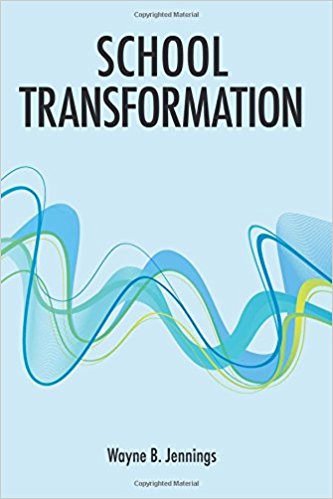 Back in the early 1970’s when I was just starting my career in education as a student at the University of Massachusetts School of Education, I visited the St. Paul Open School, where the principal was Wayne B. Jennings. My guide through the school I remember was a little boy, perhaps first grade, who had a piece of paper pinned to his shirt that included his learning schedule for that particular day. What I remember most vividly from that visit was that every student I saw in the school was doing real things; I remember in particular students with power tools working on a project building something or other (I don’t remember what it was). But it was this sense of student as builder, student as constructor, that stayed with me all these years. Now, the principal of that innovative school has written a book entitled School Transformation that should serve as a wake-up call to anyone who has a vested interest in their community’s educational institutions.
Back in the early 1970’s when I was just starting my career in education as a student at the University of Massachusetts School of Education, I visited the St. Paul Open School, where the principal was Wayne B. Jennings. My guide through the school I remember was a little boy, perhaps first grade, who had a piece of paper pinned to his shirt that included his learning schedule for that particular day. What I remember most vividly from that visit was that every student I saw in the school was doing real things; I remember in particular students with power tools working on a project building something or other (I don’t remember what it was). But it was this sense of student as builder, student as constructor, that stayed with me all these years. Now, the principal of that innovative school has written a book entitled School Transformation that should serve as a wake-up call to anyone who has a vested interest in their community’s educational institutions.
What most astounded me reading School Transformation is the sheer number of school innovations that are out there being practiced by different schools in the U.S. and around the world. Here is a partial list of some of the innovations described in the book:
- service learning
- personal learning plans
- study travel
- restorative justice
- project-based learning
- place-based learning
- internships
- sparks (activities that spark student interest, such as a visit by a magician)
- outdoor experiences
- camping trips
- field trips, mini-field trips, and simulated trips
- interdisciplinary curriculum
- school exchanges
- photography and videotaping
- drama, fine/practical arts, music, and excurricular activities
- community-based learning
- school newspaper
- role-playing
- students as ”experts”
- exhibitions and presentations
- entrepreneurship
- oral histories
- democratic class meetings
- pupil-teacher planning
- museum schools
- school-within-a-school
This list stands in marked contrast to the traditional classroom model of students sitting at their desks working on lecture-driven, textbook-driven ”content” that they will be tested on. The author of School Transformation, Wayne B. Jennings, has had a sixty-year background of experience in education in a wide variety of roles, from teacher and principal, to school board president, founder of schools (a private arts school, schools for at-risk students, several charter schools), college professor, and legislative advocate for educational change. Jennings doesn’t just say school transformation is a good idea, he has actively practiced the art of transformation schools for decades. The book contains a rich collection of insights from Jennings’ own experiences in the trenches, working with teachers, deflecting resistance to organizational change in the community, dealing with budgetary issues, and most importantly, activating students’ own inner drive to learn.
In addition, Jennings offers a cornucopia of educational wisdom from innovators of the past. I was reminded, for example, of the Eight Year Study, a 1930’s initiative that matched students in experimental/progressive schools with those in traditional schools, and saw better outcomes in the experimental group. He also mentions in several places educational innovator Don Glines, who was actually assistant principal at my own junior high school (Canyon del Oro High School, in Tucson, Arizona) when I was twelve years old! And too, there are rich references to more current innovators like Alfie Kohn, Leslie Hart (founder of brain-based learning), Pasi Sahlberg (Finnish school pioneer), and Deborah Meier (innovator of small learning communities). There are over 600 footnotes regarding research in innovative learning and an excellent list of books at the end.
I guess the question I was left with is ”why aren’t more schools doing these things?” (Jennings estimates that maybe 10% of schools are involved in some kind of innovation). He cites examples of wonderful school programs being undone overnight by the simple hiring of a new tradition-bound administrator who puts the kaybosh on the whole enterprise. This reminded me of several other examples (perhaps most significantly for me, the shutting down of the Key Learning Community in Indianapolis, Indiana, which was the pioneering school in the implementation of Howard Gardner’s theory of multiple intelligences).
Jennings provides a wealth of information on how to proceed in implementing change (e.g. offering respect and courtesy to those who oppose change, instituting careful teacher planning, providing appropriate staff development where practice of the stated innovations take place in classrooms, and being creative with limited funds). Still, I wonder why, with all the evidence Jennings provides, more schools aren’t breaking away from the traditional way of doing things since it appears that these antiquated practices aren’t paying any dividends in terms of even test scores (witness the latest round of national testing results). Wayne B. Jennings has provided a clear road map for school transformation in his new book. Now it’s up to the other 90% of our schools to do something about it.
Order School Transformation from Amazon.
This page was brought to you by Thomas Armstrong, Ph.D. and www.institute4learning.com.
Follow me on Twitter: @Dr_Armstrong


















